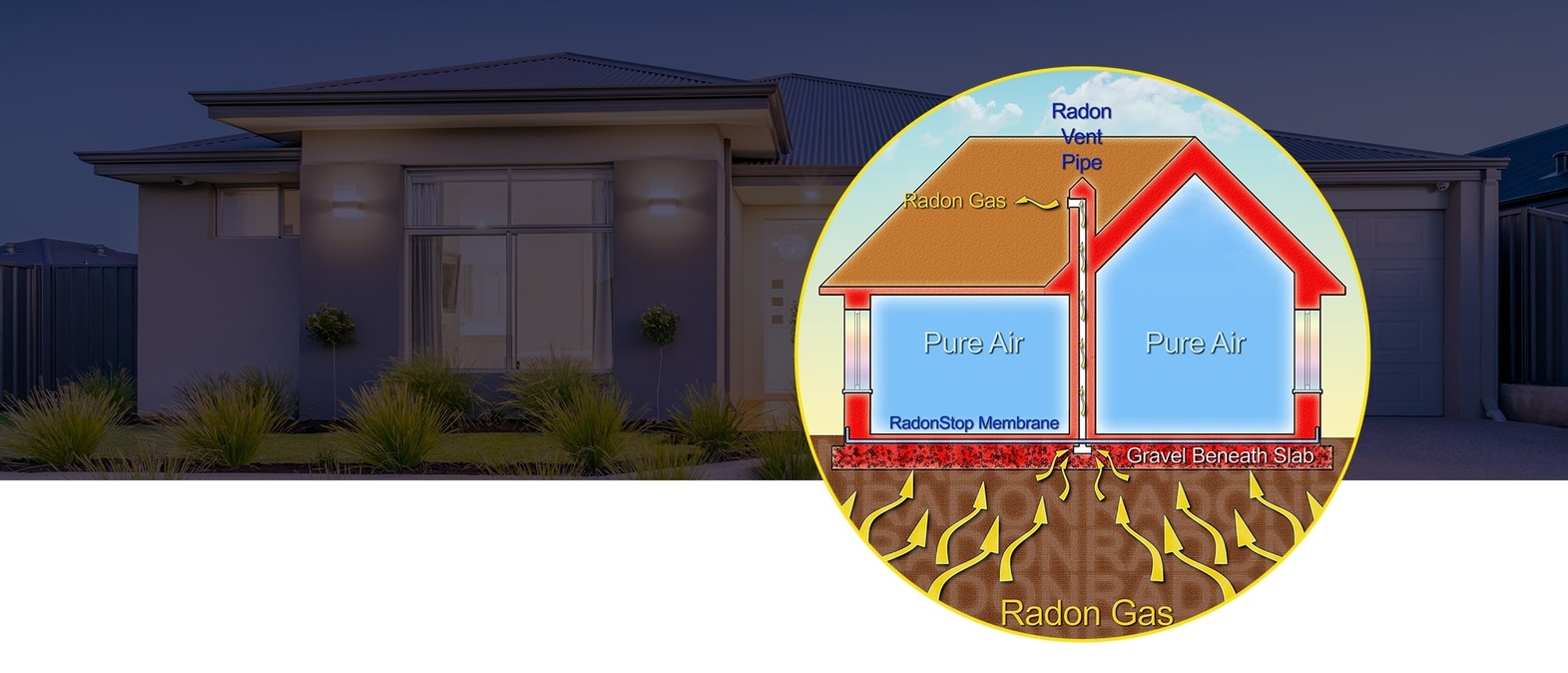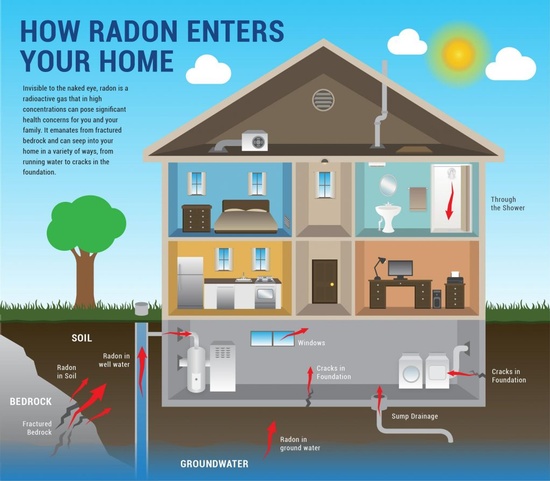THE TEST: Canisters must sit for at least 2 days detecting any Radon gas in the air. The canisters we use (the E-Perm system) can actually sit for weeks. There is also a long term test that runs for 3 months, however that test is typically too long for a real estate transaction. Canisters are secured with coded ties to prevent removal and tampering. We place signs at most all entry points explaining that there is a test going on. The test can be started before the inspection (and collected at the inspection) or placed at the inspection (and collected later). Test results are usually ready the day the canisters are collected. Late in the day pick ups, weekends and holidays may delay this.
OOPS!: The hardest part of doing a Radon air test for a real estate transaction is getting occupants to follow the rules! As well, we find many real estate agents not aware of these protocols that have been in place for over 25 years. The hardest one to follow is called "Closed House Conditions". ALL windows THROUGHOUT the house MUST be closed at least 12 hours before starting the test. So we usually tell our clients to make sure that ALL windows are closed the night before. Yet we still show up to homes with windows open.
When this happens we have three protocols to follow.
- We do not start the test at all (especially if we feel we can not trust the occupants to keep windows closed).
- We close the windows and then have to add two days to the test run (which is typically what we always do).
- The windows are closed and the test started at least 12 ours later (we don't do this one).
Then the opposite happens when windows are closed, but we show up to collect the canisters and find the windows are now open! That actually voids the test. Over the years (21 to be exact), when we retest, we find that the levels are much higher with the windows open. Versus the second test with windows fully closed.
The other confusion comes from knowing where to place the canisters. The EPA actually has two protocols. One for home owners, one for home buyers. When you live in the house, you should test in the lowest level you regularly use. If you are buying a house, you test in the lowest level suitable for use. This specifically includes an unfinished basement. As you may choose to finish this area in the future. This same idea should apply if you test in a home you live in, if you think you may finish the basement some day. Certainly there are some conditions where "suitable use" may not be clear, such as a workshop, laundry area, craft area. Where the basement is not finished, however you may be spending a few hours. Or a basement that is nice and clean to be in, but you can't access it from the living space or stand up! We would then talk this over with you to determine which level is best.
Another fact that we have data on is the difference between the Radon levels in the basement and the first floor. We consistently find levels in the basement, to drop by half on the first floor. So you can have 5.0 pCi/L in the basement, but 2.5 pCi/L on the first floor!
There may conditions that we deem not at all suitable to do the test. As noted above, we do not want to have the reputation for just taking your money and doing the test no matter what. So we will be as honest as we can with you, about conditions, location and the facts.
WHAT'S RADON YOU ASK?: Radon gas is created as part of the process when uranium radioactively decays. Its predecessors are solid, until Radium reaches its half life to become a gas (Radon). It does not actually come from granite. Granite makes great countertops, statues and steps. It does not "make" Radon. The gas then seeps through any access point into a home. Common entry points are cracks in the foundation, poorly sealed pipes, drainage or any other loose or porous areas. Once in the home, the gas can collect in certain areas especially basements and other low lying, closed areas. Then in 3.8 days Radon reaches its half life and releases charged particles. Those are the ones that can damage your cells. Very much the same way the Sun can cause damage and possibly skin cancer.
The Environmental Protection Agency of the US Government has a recommended action level of 4.0 pico curies per liter (pCi/L) as a level to stay below based on a life time of exposure at 18 hours a day. Since Radon gas is considered radioactive, long term exposure of high levels increases your risk of lung cancer.
Having test results at 4.5 pCi/L is not going to cause much of a difference than if they came in at 3.5 pCi/L. And being just over 4.0 pCi/L does not mean you suddenly are living in an unprotected nuclear power plant. So don't be so focused on being technically under 4.0 pCi/L. Officially there is no such thing as a pass or fail. The EPA number is just a recommendation. You personally may want the lowest number possible, even if it came in at 2.0!
CONCERNED?: Don't be overly concerned. But have knowledge (both of Radon levels and your own family history). You are on planet Earth. Radon has been found in homes in all 50 states, and around the world. No location is immune. You have been breathing it in all your life. Just as you have been exposed to the Sun all your life. Do people get skin cancer, unfortunately yes. Can someone get lung cancer from Radon, unfortunately, yes. Concentrations of radon causing materials in the soil can vary in the same neighborhood. The only way to tell for sure is to have a home tested. Tests can be taken incorrectly, so you should aware of how your test should be done, and is being done.
If high concentrations of radon are found in your home, you have several options. Since radon is only a problem when it is concentrated in high volume, it may be necessary to limit the amount of radon getting into the home by sealing or otherwise obstructing the access points. Once again, a professional should be engaged to ensure that the radon is effectively blocked. Typical radon mitigation systems can cost between $1,000 and $1,500. The cost will depend on access to install components, additional work to seal the basement and how aggressive a system you need to correctly reduce your level. Most Radon air mitigation systems can get levels down around 1.0 pCi/L, if the original levels were not too crazy high.
Since January 2015 in NH: 310-A:189-a Airborne Radon Mitigation Installer Certification Required. – "I. (a) Any person engaged in the design or installation of airborne radon mitigation devices in New Hampshire shall hold a current certification from either the National Radon Proficiency Program offered by the American Association of Radon Scientists and Technologists, Inc., or the National Radon Safety Board." There are more details to 310-A: 189-a at the State web site.
If you're buying or selling a home, radon can be a significant issue. Buyers should be aware of the radon risk and determine whether a radon test is desirable. When in doubt, the EPA always recommends testing. If test results already exist, make sure they are recent (one year is acceptable) or that the home has not been significantly renovated since the test was performed. If in doubt, get a new test done. If you're selling a home, having a recent radon test is a great idea. By being proactive, you can assure potential buyers that there is no risk and avoid the issue from the start.
WAIT, THERE'S MORE!: If the home is on a well, whether private or community well, Radon gas can also be in the water. Unfortunately Radon water is even more confusing. The EPA does not have a recommended action level for Radon gas in water. Many State's create their own suggestions for taking action. And honestly it's too difficult to really put a number on an "action" level. Unlike Radon air that's always there, Radon water may only be introduced into the home, if the water is actually running. All faucets off, no running water, it's not really off gassing. So you can't take the Radon water level results and just add it to a Radon air level. There are some concerns about drinking water with very high levels of Radon, as it relates to stomach cancer. However those instances have been so rare, this aspect of the Radon topic does not come up often or at all.
There is a way to exactly calculate how much Radon in the water, is affecting the air. Which has been simplified to a "rule of thumb" ratio. For every 10,000 pCi/L in the water, 1.0 pCi/L can be released into the air. Which is why many States use the 10,000 pCi/L level as their recommended action level.
So how do you decide what level is okay? Take that ratio in reverse. If you consider that the average outside Radon level is thought to be around 0.3 to 0.4 pC/L. Then that would be about 3,000 to 4,000 pCi/L in the water. If someone told you that 3,000 to even 5,000 pCi/L is not acceptable, you would have to leave the planet. Because just standing outside, exposes you to the same risk.
We consider the only appropriate correction for Radon in water is a bubble up system. We have nothing nice to say about the charcoal system, I don't care how much less it costs. The bubble up systems are going for about $4,000 to $5,000. Which is why you really have to have an alarmingly high level of Radon in water to make it worth the cost.
When we do a Radon water test, we take two samples. Not just one. The actual test is started within a few hours of taking the samples. Remember, Radon has a half life of 3.8 days. So if the sample is sitting in someone's vehicle, then sitting in a Labs overnight drop, 12 hours of decay can pass before the test is even started.
FINALLY DONE WITH THIS TOPIC: Never! But that's enough for now. Always feel free to call with any questions. Take most of what you read on line with a grain of salt.

